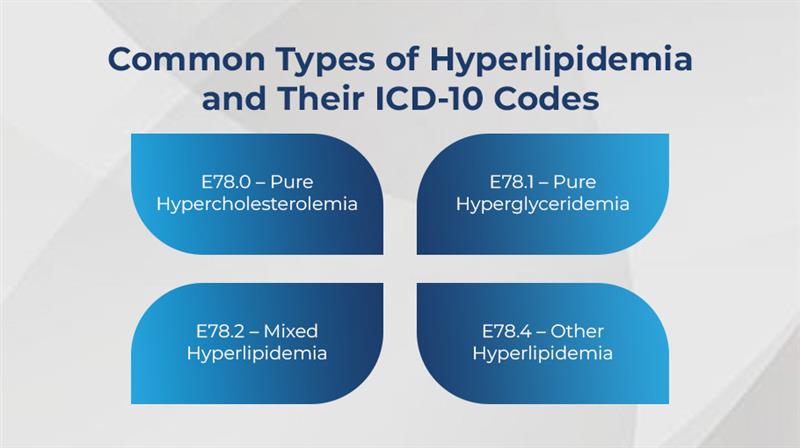Hyperlipidemia is a prevalent metabolic disorder characterized by elevated levels of circulating lipids particularly cholesterol and triglycerides. Left unmanaged, it contributes significantly to atherosclerotic cardiovascular disease (ASCVD), cerebrovascular events and acute pancreatitis.
From a clinical and administrative standpoint, accurate ICD-10 coding is essential—not only for optimized treatment planning but also for appropriate reimbursement and population health management. Among the most frequently applied codes for this condition is ICD-10 E78.5, which refers to hyperlipidemia, unspecified. In the context of professional billing solutions and medical coding outsourcing, proper use of this code can impact both clinical and financial outcomes.
ICD-10 code E78.5 – Hyperlipidemia, unspecified is used when the clinical documentation confirms dyslipidemia but lacks detail regarding the lipid type (e.g., LDL cholesterol, triglycerides, or mixed). It is a billable code that reflects the presence of abnormal lipid metabolism without specifying the exact profile.
E78.5 is typically applied in scenarios where:
This code is often encountered during initial consultations, urgent care settings or when electronic medical records (EMRs) are incompletely populated.
Although E78.5 is valid, it should not be a default choice. Overreliance on unspecified codes can result in:
Whenever possible providers should aim to document specific lipid parameters to facilitate assignment of a more granular ICD-10 code.

Hyperlipidemia comprises multiple subtypes, each representing distinct pathophysiological lipid abnormalities. The following codes should be utilized when documentation permits:
Isolated elevation of LDL cholesterol, often familial.
Elevated serum triglycerides, which may predispose patients to pancreatitis.
Simultaneous elevation of both cholesterol and triglycerides.
Used for lipid disorders not otherwise classified (e.g., elevated lipoprotein a ).
Recognizing these distinctions allows for enhanced diagnostic precision, improves clinical documentation and supports revenue cycle integrity through accurate coding.
Hyperlipidemia is predominantly asymptomatic which underscores the importance of routine screening. However, in advanced cases or with genetic dyslipidemias, patients may present with:
The gold standard for diagnosis is a fasting lipid panel which evaluates:
Additional assessments may include apolipoprotein B, lipoprotein(a) and non-HDL cholesterol in complex or high-risk cases.
From a medical coding perspective, it is essential to review laboratory values and provider notes carefully. When specific lipid abnormalities are documented, defaulting to E78.5 should be avoided. Engaging professional billing solutions can help ensure that such nuances are correctly captured in claims data.
Management should be individualized based on ASCVD risk, LDL goals and comorbidities. Regular lipid monitoring is recommended every 3–6 months after initiation or adjustment of therapy.
Accurate ICD-10 coding does more than ensure payment; it directly impacts patient care, insurance audits and healthcare analytics. Using E78.5 as a default code can limit reimbursement or misrepresent clinical data.
What is the ICD-10 code E78.5 used for?
E78.5 is used for cases where hyperlipidemia is diagnosed but the specific type is not specified in the documentation.
What is the difference between E78.2 and E78.5?
E78.2 refers to mixed hyperlipidemia (high cholesterol and triglycerides), while E78.5 is for unspecified cases without detailed documentation.
Is hyperlipidemia the same as high cholesterol?
Not exactly. High cholesterol is one type of hyperlipidemia. The term includes both high cholesterol and high triglyceride levels.
Can hyperlipidemia be managed without medication?
Yes, in mild cases, lifestyle changes like diet and exercise can effectively manage hyperlipidemia.
Why is proper ICD-10 coding important for hyperlipidemia?
Accurate coding ensures correct billing, better patient care documentation and efficient use of professional billing solutions.
ICD-10 code E78.5 remains an important tool in the diagnosis of unspecified hyperlipidemia, but should be used judiciously. When more detailed clinical information is available, more specific codes offer better insight into the patient's condition and lead to improved reimbursement outcomes.
Healthcare providers and billing professionals must work hand-in-hand—or consider outsourcing to medical coding specialists—to ensure the highest level of accuracy, compliance and care.
Optimize billing, claims and collections with expert RCM support let our professionals handle the process so you can focus on patient care.
